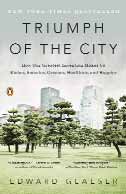SEJournal Online is the digital news magazine of the Society of Environmental Journalists. Learn more about SEJournal Online, including submission, subscription and advertising information.

Book Shelf
Triumph of the City: How Our Greatest Invention Makes Us Richer, Smarter, Greener, Healthier and Happier
By Edward Glaeser
Penguin Press, $29.95
Reviewed by JENNIFER WEEKS
In 2009, the world passed a milestone: For the first time, 50 percent of humans around the globe lived in cities. That percentage continues to grow. In the United States, the statistic is even more pronounced — more than two-thirds of Americans now live in urban areas.
In Triumph of the City, Harvard economist Edward Glaeser makes a forceful case that cities are humanity’s “greatest invention.” Cities spawn all kinds of innovations, such as new art concepts and high technology advances. They are, in Glaeser’s view, the greenest way to live.
That may seem counterintuitive to readers who equate urban life with traffic jams, air pollution and sewers. As Glaeser acknowledges, cities, especially in developing countries, concentrate millions of the world’s poor into dark and unhealthy slums. But when modern cities are compared with other models — especially low-density, car-dependent suburbs — Glaeser says cities are far greener.
According to Glaeser and his colleagues, living in densely settled urban areas greatly reduces gasoline use because people don’t have to drive as far to get their daily errands done. A household in a census tract with more than 10,000 people per square mile uses 687 gallons of gas yearly, compared to 1,164 gallons for a household in an area with fewer than 1,000 people per square mile (about one household per acre).
Urban residents also use less electricity, which accounts on average for two-thirds of residential energy use. As with gasoline, there are variations among cities. Coastal California cities (San Diego, San Francisco, Los Angeles and San Jose) are among the greenest, while less-dense Sun Belt cities such as Houston and Memphis are among the dirtiest. Older Northeast and Midwest cities lie in between these extremes.
In Glaeser's view, it would make sense to have more growth in green regions because going elsewhere will do more damage.
To make his point that growth can be progressive, Glaeser compares two British visions for what cities should be: the traditional view, represented by Prince Charles’ model community of Poundbury (a walkable community in Cornwall, similar to New Urbanist projects in the United States, although less car-dependent), and the larger-scale policies of socialist London mayor Ken Livingstone, widely known as “Red Ken.”
Livingstone’s approach combines high-rise construction (which expands London’s tax base, giving the city more money to spend on social programs) with quality-of-life policies like congestion pricing and support for mass transit.
“The urban model is green when used by real people,” Glaeser argues. “High costs of land restrict private space, and density makes car use far less attractive. Urban living is sustainable sustainability. Rural ecotowns are not.”
Chicago and Vancouver are two cities that Glaeser believes are getting it right, building densely but intelligently (Vancouver has narrow skyscrapers that leave plenty of open views) while also emphasizing trees and parks.
Most urban growth, however, is taking place in the developing world. In Glaeser’s view, the most important tests for urban development in the coming decades will occur in China and India. If those nations adopt the model of dense urban growth with mass transit, world carbon emissions will be more manageable than if they become as car-dependent as the United States.
Developing countries will also have to solve the problems of urban poverty — no small challenge, as anyone who saw the movie Slumdog Millionaire realizes. In Europe and the United States, making cities healthy places to live required huge government investments in clean water, sanitation, mass transit and housing. Some developing countries are already on that path (Singapore and Bogota, Colombia are examples) and have earned praise for making their cities livable for both the poor and the wealthy.
Glaeser doesn’t downplay how ugly conditions can be for poor people in mega-cities such as Rio de Janeiro. But, he argues, it’s essential to remember that poor people are better off in cities than in rural areas, where there are fewer services and opportunities.
“The part of the world that is rural and poor moves glacially — only occasionally shocked by famine or civil war, or, very rarely, something as helpful as the Green Revolution — while the part of the world that is urban and poor is changing rapidly. There is opportunity in change,” Glaeser wrote.
Glaeser argues for policies that give cities “a level playing field” instead of providing incentives to flee to suburbs. They include free trade, pro-immigration policies to let talent move freely from place to place, and carbon taxes to make energy users pay the full social costs of their actions.
With steps like those, especially in developing countries, Glaeser speculates that “American suburbs will begin to look like an exception rather than a prognosis of the world’s future.”
Jennifer Weeks is a Boston-based freelance writer and a member of SEJ’s board of directors.
* From the quarterly newsletter SEJournal, Spring 2012. Each new issue of SEJournal is available to members and subscribers only; find subscription information here or learn how to join SEJ. Past issues are archived for the public here.












 Advertisement
Advertisement 



